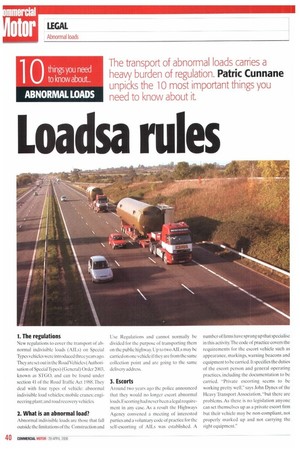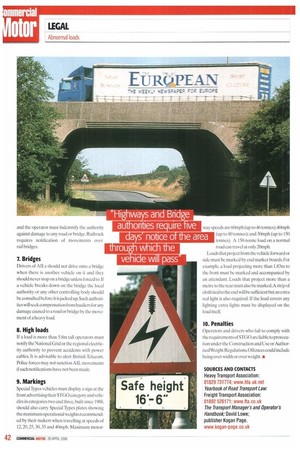Loadsa rules
Page 40

Page 41

Page 42

If you've noticed an error in this article please click here to report it so we can fix it.
The transport of abnormal loads carries a heavy burden of regulation. Patric Cunnane unpicks the 10 most important things you need to know about it.
1. The regulations
New regulations to cover the transport of abnormal indivisible loads ( A ILs) on Special Types vehicles were introduced three years ago. They are set out in the Road Vehicles (Authorisation of Special Types) (General) Order 2003, known as STGO. and can be found under section 41 of the Road Traffic Act 1988. They deal with four types of vehicle: abnormal indivisible load vehicles; mobile cranes: engineering plant; and road recovery vehicles. Use Regulations and cannot normally be divided for the purpose of transporting them on the public highway. Up to two AILs may be carried on one vehicle if they are from the same collection point and are going to the same delivery address.
3. Escorts
Around two years ago the police announced that they would no longer escort abnormal loads. Escorting had never been a legal requirement in any case. As a result the Highways Agency convened a meeting of interested parties and a voluntary code of practice for the self-escorting of AILs was established. A number of firms have sprung up that specialise in this activity.The code of practice covers the requirements for the escort vehicle such as appearance, markings, warning beacons and equipment to be carried. It specifies the duties of the escort person and general operating practices, including the documentation to be carried. "Private escorting seems to be working pretty well," says John Dynes of the Heavy Transport Association, "but there are problems. As there is no legislation anyone can set themselves up as a private escort firm but their vehicle may be non-compliant, not properly marked up and not carrying the right equipment."
4. The vehicles
Special Types vehicles fall into three weight categories: Category 1 — up to 50 tonnes GCW Category 2—up to 80 tonnes GCW Category 3— up to 150 tonnes GCW They are permitted to be up to 2.9m wide and, in exceptional circumstances, up to 6.1m wide. The overall length of the vehicle and load should not exceed 27.4m and the maximum weight should not exceed 150,000kg. No single wheel should place more than 8,250kg on the road and no single axle more than 16,500kg.The limits can only be exceeded by a Special Order from the transport secretary Vehicle excise duty fora Speciallypes vehicle is £2,585 or £2,085 for those meeting the reduced pollution requirements,
5 Attendants
Attendants are required on Special Types vehicles if the load is more than 3.5m wide; if the overall length of the vehicle (not including tractor unit in the case of attics) is more than 18.3m; if the vehicle and trailer exceeds 25.9m; and if the load projects more than 1.83m beyond the front of the unit or more than 3.05m beyond its rear. Vehicles travelling in a convoy of more than three need only carry an attendant on the first and last vehicles.
6. Notification
While the police no longer offer escort services. AIL operators must give them two days notice of any Special Types movements in their region. The notice period applies where loads are more than 2.4m wide;the vehicle and load is more than 18.3m long; the combination of vehicles and trailers is more than 25.9m long;the load projects more than 3.05m behind the vehicle: and the gross weight is more than 80.000kg.
But notification doesn't end there. Highway and Bridge authorities require five days' notice of the area through which the vehicle will pass and the operator must indemnify the authority against damage to any road or bridge. Railtrack requires notification of movements over rail bridges.
7. Bridges
Drivers of A I Ls should not drive onto a bridge when there is another vehicle on it and they should never stop on a bridge unless forced to. If a vehicle breaks down on the bridge the local authority or any other controlling body should be consulted before it is jacked up. Such authorities will seek compensation from hauliers for any damage caused to a road or bridge by the movement of a heavy load.
IL High loads
If a load is more than 5.8m tall operators must notify the National Grid or the regional electricity authority to prevent accidents with power cables. It is advisable to alert British Telecom. Police forces may not sanction AIL movements if such notifications have not been made.
9. Markings
Special Types vehicles must display a sign at the front advertising their STGO category and vehicles in categories two and three, built since 1988, should also carry Special Types plates showing the maximum operational weights recommended by their makers when travelling at speeds of 12, 20, 25, 30, 35 and 40m ph. Maximum motor way speeds are 60mph (up to 46 tonnes); 40mph (up to 80 tonnes); ancl 30mph (up to 150 tonnes). A 150-tonne load on a normal road can travel at only 20mph.
Loads that project from the vehicle forward or side must be marked by end marker boards For example, a load projecting more than 1.83m to the front must be marked and accompanied by an attendant. Loads that project more than a metre to the rear must also be marked.A strip of cloth tied to the end will be sufficient but an extra red light is also required. If the load covers any lighting extra lights must be displayed on the load itself.
10. Penalties
Operators and drivers who fail to comply with the requirements of STGO are liable to prosecution under the Construction and Use orAuthorised Weight Regulations. Offences could include being over width or over weight. •




















































































































































































































